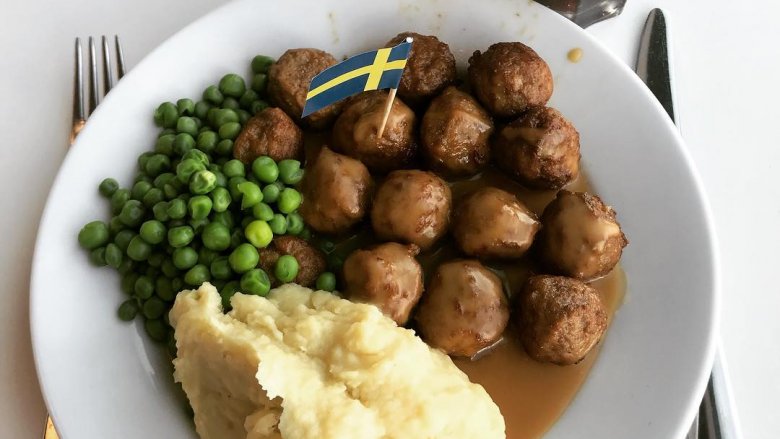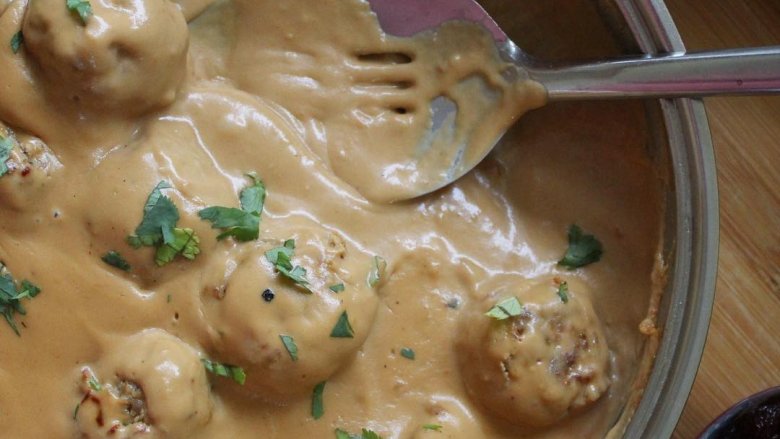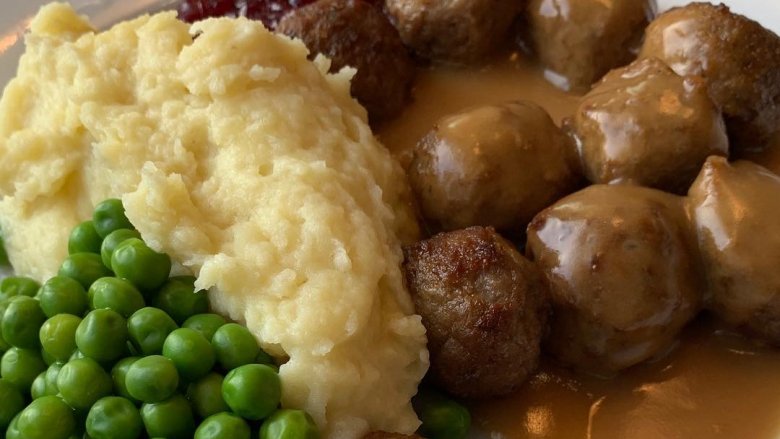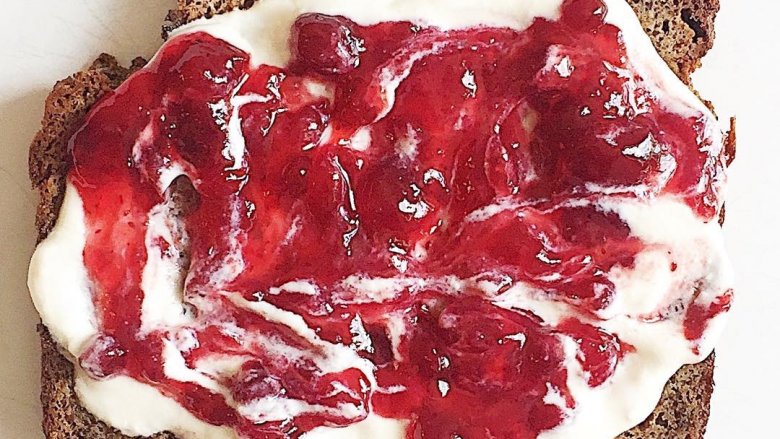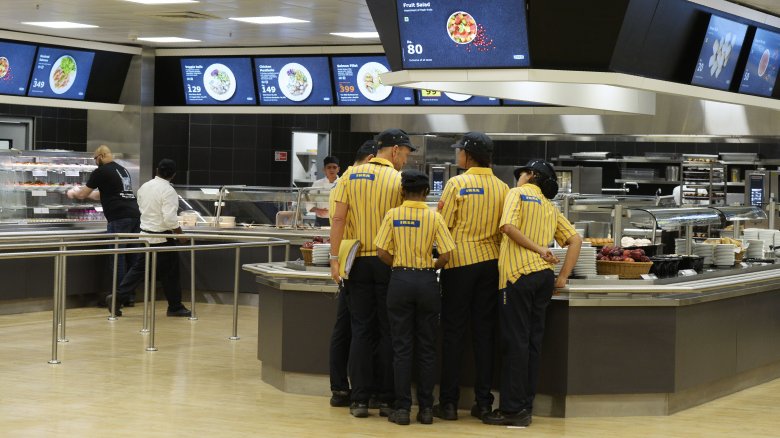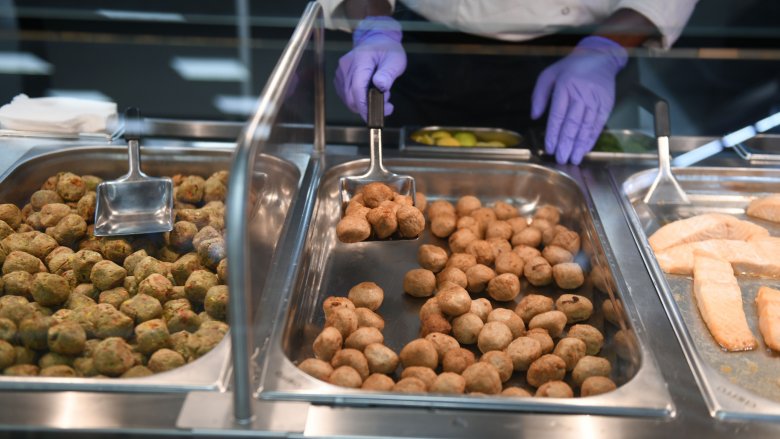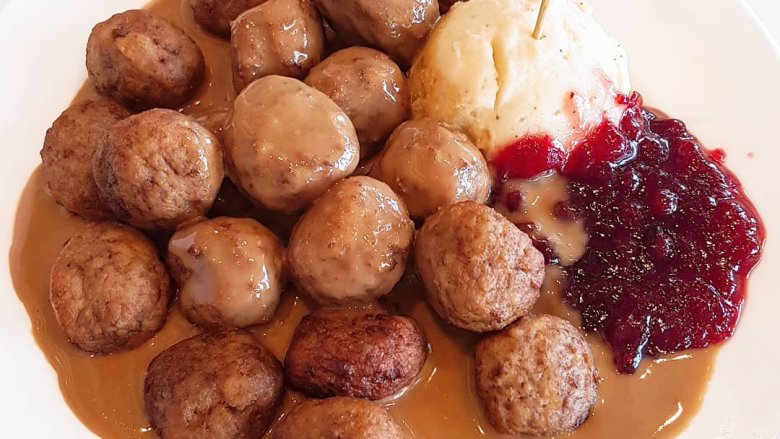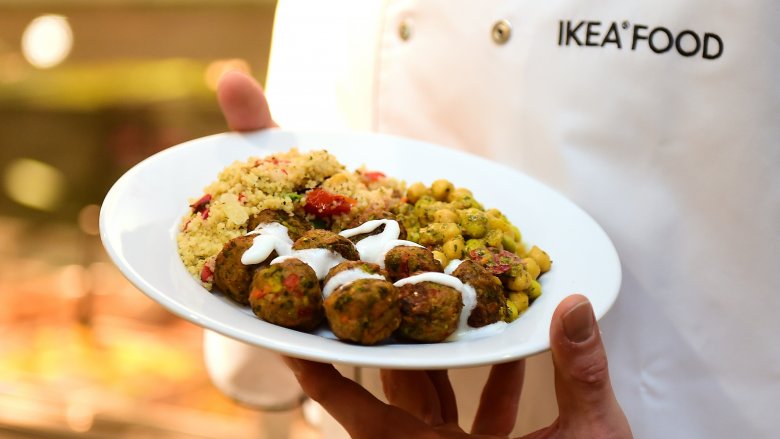This Is Why Ikea's Meatballs Are So Delicious
A trip to Ikea for the best bargains in flat-packed Scandinavian design always begins with such promise. As you pull into the massive expanse of the parking lot, with the grandeur of that gigantic blue and yellow building stretching over the horizon, the multicolored flags festooning the entrance flapping in the wind, you imagine a more perfect, organized life; a life where your dining chairs stack neatly inside your 100 square foot dining nook, your possessions are arranged by color in floor-to-ceiling shelves and cubbies (so many shelves and cubbies!), and you can conceivably cover every surface of your kitchen in butcher block for under $800.
Flash forward three hours, and a lot has probably changed. A small child has crashed an entire sideways-rolling shopping cart into your ankles. You've had a divorce-level argument with your significant other over the subtle differences between the BRIMNES and the KVIKNE line of functional and affordable wardrobes. An ancient woman has sneezed directly into your mouth. And just when you're ready to give up and go home, you spot it: The Ikea cafeteria, and their plates piled high with gravy-soaked meatballs.
The meatballs at Ikea have successfully halted the death spiral of more than one rapidly-declining shopping trip. We can all agree that they're amazing, but is this a function of the quality of the meatballs themselves, or are there other psychological factors in play? We took a look at the reasons why Ikea's meatballs are so delicious.
They're made with all-natural ingredients
Ikea sells about one billion meatballs worldwide, each and every year. Because of this insane volume, we wouldn't blame you for assuming that these freezer-stable spheres of sustenance are absolutely loaded with all sorts of weird additives, preservatives, and laboratory-grade chemicals. But amazingly, Ikea manages to deliver a billion of these babies to hungry shoppers each year, using all-natural ingredients.
The Ikea website lists the ingredients of their meatballs (which Ikea calls ALLEMANSRÄTTEN), and the rundown is surprisingly simple: Meat (a combination of pork and beef, for texture, flavor, and juiciness), onion, breadcrumbs, egg, water, salt, and pepper. This gentle seasoning allows the flavor of the meat to shine through, and makes Ikea meatballs one of those rare quick-service meals that's actually made of real food, and not adulterated with a bunch of weirdo extra ingredients. Whether you rawdog them or eat them smothered in that butter-and-cream laden gravy, you can be confident that for once in your life, you're eating food that's not all that different than something you might cook yourself at home.
They're loaded with salt (and salt is delicious)
If there's one thing that's a little unnerving about the nutritional makeup of Ikea's legendary meatballs, it lurks a little further down on the nutritional facts panel. According to Ikea's website, the 12-meatball version of their KÖTTBULLAR plate packs a pretty serious amount of salt into your bloodstream, to the tune of 1,520 milligrams. This puts you more than halfway toward the 2,300 mg daily allowance for adults recommended by the Center for Disease Control, in just one sit-down snack.
What's the link between saltiness and deliciousness? According to Fine Cooking, human beings tend to think salt is delicious because of our biological need for sodium chloride. But there's more to salt's appeal than simple biology. Salt can enhance sweetness, help block bitter flavors, and can help make meats juicier. Because some flavor compounds are too subtle for our dumb orangutan tongues to detect, a little extra salt brings all of those flavors forward and makes the taste of some foods (including Ikea's meatballs) more pronounced.
They're not a part of your everyday diet
Let's talk for a minute about the idea of "manufactured scarcity." Basically, the idea is that by artificially denying access to something, you'll crave it much more than you ordinarily would. Want an example? Look at the McDonald's "McRib" sandwich, which has had several "farewell" tours and is constantly rumored to be discontinued, but which still gets trotted out once or twice a year, usually to coincide with either low prices in the "ground pork paste" commodities market, or in response to a low-earning quarter at the Golden Arches. Every year, customers go crazy for the McRib, not because it's an excellent sandwich, but because of its limited availability.
The same concept probably applies to your love of Ikea meatballs. If you ate them every single day of your life (a scenario in which your life is also very weird and kind of depressing), you probably wouldn't find that you enjoyed them quite as much. But as a once-or-twice a year treat? They tend to seem a lot more special and therefore delicious.
That lingonberry jam, though
In the imaginary paperback collection of pretend Ikea jokes that we keep on the nonexistent bookshelves at Mashed headquarters, a quick glance reveals that "lingonberry" is the punchline to at least 40 percent of them. And for good reason: Though most of us may not know our lingonberries from our snozzberries, we can all agree that the sharp tartness of that jam pairs perfectly with those wondrous meatballs.
According to Tasting Table, there are two main reasons why you may enjoy a slice of cheddar cheese with your apple pie, dipping french fries into your Frosty, or dabbing your salty meatballs in a swipe of sweet-and-tart lingonberry jam. First, the salt in the meatballs and gravy activates specific sweetness receptors on our tongues that only come alive in the presence of salt, making sweet foods appear to taste even sweeter. The second reason comes down to biology: Our bodies need both salt and sweets (since our bodies tend to think that sweet foods are the most energy-rich), and sticking both things in our mouth at the same time makes our dumb brains think we've hit the evolutionary survival jackpot.
All of that shopping makes you hungry
Have you ever noticed that during prolonged periods of stress or anxiety, or after walking several miles like a rat in a maze made of tiny fully-furnished micro-studio apartments, guided only by light-up arrows projected onto the floor to keep you from losing your way, you tend to get ravenously hungry? That's never more true than after an afternoon shopping at Ikea.
By the time you stumble upon the Ikea cafeteria (not-so-accidentally located in the center of the store, when you are at your lowest point physically and psychologically, questioning everything you've ever known, and too enmeshed in a web of fiberboard coffee tables and paper lantern floor lamps to navigate your way to the exit in search of other sustenance), you've probably developed a serious pit in your empty stomach.
That's when a plate of Ikea meatballs is there, right when you need it, to fill the emptiness both in your stomach and in your very spirit. A part of what makes a plate loaded with perfect spheres of meat so delicious is that they're there, at the exact moment you need them most.
They definitely don't contain horse (anymore)
"When I'm hungry, I reach for a big plate piled high with shredded horse meat," says no one ever.
That may be because, for better or for worse, Americans just never managed to embrace "eating horse" as a big part of our culinary culture — unlike they have in France. That's why in 2013, when a health inspector from the Czech Republic found trace amounts of horse meat in Ikea's frozen meatballs, the public outcry was swift.
Though the horse-laden meatballs never made it to US shores, the collective heebie-jeebies on the part of consumers was enough to make even the biggest meatball fans think twice. It was also enough for at least six years of exhausted and overworked concessionaires at the Ikea cafeteria to roll their eyes dismissively and say, "No, for the thousandth time, our meatballs are USDA inspected and made strictly with beef and pork. Here, have a free lingonberry sundae."
And once you know what they're not made of... they just taste better.
The Ikea cafeteria is the only area that has natural light
Think about this one, for a second. When you step into the glistening Ikea showroom, bang a quick a left at the brightly colored kids' play area, and head up the escalator to the shiny world of prefabricated birch bookshelves and primary-colored EKTORP sofabeds, all of the light in the building is provided either by overhead fluorescents, product-accentuating pendant spotlights, or the warm glow of hundreds of floral fiber-optic table lamps. Just as with other businesses whose success is built partially on sensory deprivation (see also: immersion therapy facilities, or the entire city of Las Vegas, Nevada), you won't see daylight again until you leave.
That's part of why the arrival of the Ikea cafeteria at the midway point in your shopping journey seems so serene and inviting; in many Ikeas, the cafeteria is the only area in the store that includes any windows or natural light. That sudden feeling of calm that floods your brain and makes you feel almost like a human being again may be a big part in why the accompanying meatballs seem to taste so good.
Potato starch for texture and allspice for flavor
Though they're not listed on the nutritional facts panel for Ikea's line of cook-at-home frozen ALLEMANSRÄTTEN meatballs, the corporate website's official recipe for making Ikea-style meatballs yourself from scratch lists a couple of surprise ingredients: cold boiled potatoes and ground allspice.
In this case, the potatoes probably act as a binder for the other ingredients, in the same way you would add breadcrumbs to a meatloaf to keep it from falling apart. The potato starch also contributes a light, springy texture to the finished meatballs, making them feel less heavy and helping them to hold their shape. And the allspice? It adds a mysterious, can't-quite-put-your-finger-on-it flavor (think of it as a light combination of nutmeg, cinnamon, and cloves) that may be hard to pin down, but adds a warm, homey sweetness to savory dishes.
They're cheap and satisfying
In some parts of the country, a plate piled high with Ikea meatballs, with a side of vegetables, will set you back just $5.99. Compare that to other options you can get at around the five dollar mark, such as a sad, insipid burger from a drive through joint, a big bag of chips, or a few pieces of worthless fruit, and the dining options at Ikea represent just as good a value as their furniture. Throw in a drink (with unlimited free refills) and you've got a complete meal, no matter what time of day you finally collapse exhausted into a cafeteria chair. And unlike lower-calorie, lower protein snacks, sitting down to a meatball meal convinces your brain that you've had a real, complete meal, and is likely to leave you feeling satisfied for longer... giving you that last burst of strength and energy needed to navigate the self-serve furniture section, get through the mobbed checkout line without saying anything rude to anyone, and gleefully ride your cart through the parking lot on your way home.
They're consistently comforting and often eaten after a life upheaval
There's another psychological factor in play, when you find yourself feeling the warm-and-fuzzies when reminiscing about your last meatball plate, and it may have something to do with the other things happening in your life when you eat them.
For better or for worse, trips to Ikea usually coincide with some major change in your life; you've left your parents' house and are striking out on your own for the first time, or you've moved to a new city and need to furnish your barren apartment, or your wife has left you penniless and without so much as a coffee table to put your much-needed cocktail on at the end of the day.
Whatever the particular circumstance, you're probably at Ikea because you're going through a major life change, and that's when those meatballs appear: Unnervingly perfect spheres of meat, covered in a thick, salty layer of cream, butter, and fat, served in a warm, clean environment, where the world still makes sense. It's comfort food when you need comforting the most, and probably contributes to the positive associations we have with Ikea meatballs.
Beef and pork isn't the only option
Suppose you love a good meatball, but wish they didn't have to contain so much pesky meat. Maybe you're trying a lower-fat diet, have ethical concerns about the sustainable sources of your ingredients, or have religious beliefs that prohibit the one-two punch of beef and pork found in the classic recipe. Yes, Ikea still has a meatball for you.
In addition to the classic variety, Ikea offers three additional meatballs in the United states: A chicken-based version (KYCKLINGBULLAR), a vegetarian meatball (GRÖNSAKSBULLAR), and believe it or not, a meatball formed from fish, made from ASC-certified salmon with the addition of MSC-certified cod and then seasoned with seaweed and lemongrass "to capture the fresh taste of the Nordic sea in one tasty ball." The new "salmon balls" (snicker) are sold as part of a meal for $5.99 (in some locations) and come with two sides, fennel and cabbage with buckwheat sprinkles and mashed potatoes.
